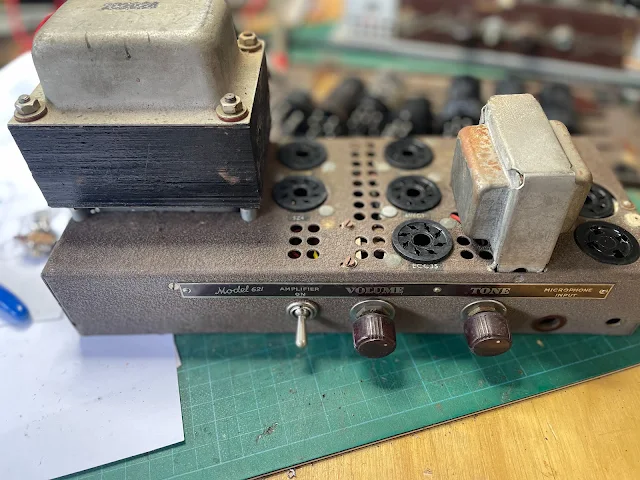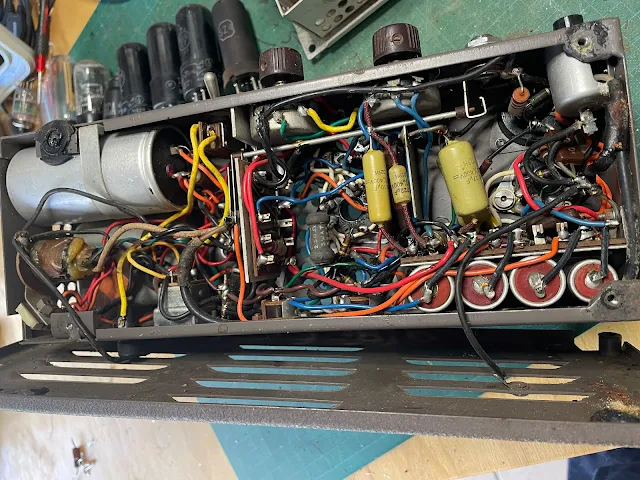Despite saying never again - I now have another Bell & Howell projector amp. This is a 621 model from 1951, which as far as the amp is concerned, looks almost identical to my 601 from 1949. I believe the main differences were with the actual projector itself - the 621 being a later and improved model.
Unlike the last amp, where I rebuilt everything on tag boards following the original schematic, apart from removing non-audio related components, I did as little as possible to this one. Surprisingly, it didn’t take as long as I expected. Many people gut these and start fresh, often going down the tweed fender path.
It's in the 10w - 15w output range, using a pair of cathode biased 6V6. Controls are simple: volume and tone. The tone control is best described as a bass cut, with a few tricks to it.
POWER
110v on the primary side, I'm in Australia, so it needs a stepdown transformer. There's also a weird 91v tap, which I think has somehting to do with the projector. It also had the infamous death cap across it, which I removed.
6.3v heaters with centre tap, elevated via the 6V6 cathodes
5v heaters for rectifier
B+ is around 350V
OUTPUT TRANSFORMER
Said to be a Schumacher transformer, same as old Fenders. It looks small for an output transformer, but it doesn't seem to be lacking in any areas.
Primary - Yellow, Black (CT), Red. 420 Ω plate to plate
Secondary - Black (GND), green 8Ω, blue 16Ω
- 16 Ω tap → voltage ratio ≈ 23 : 1 (15.55 V ÷ 0.675 V)
- 8 Ω tap → voltage ratio ≈ 33 : 1 (15.55 V ÷ 0.474 V)
- Reflected primary impedance comes out at ≈ 8.5 kΩ from either tap

621 TONE CONTROL
Probably the most interesting part of the amp is the tone control. It's quite different to the better known model 385 Filmosound. Not even a close comparison, as the 385 is a James style equaliser with a very hard to find 3meg dual-gang pot.
Instead of the familiar FMV or James/Bax stack that sits between two stages, this amp has its entire tone circuit right on the cathode of the ECC35 triode - it's primarily a bass cut. A single 50 kΩ pot and three capacitors juggle the amount of local feedback inside that valve and the amount of global negative feedback (NFB) returned from the output transformer.
Keep in mind that this is from LTspice, so it's not going to be spot-on, but it will give an idea of what it does. All three capacitors interact with one another and the negative feedback.

Decreasing the value of C27 shifts the frequency where the bass starts rolling-off down. I changed mine from 50n down to 33n, as the 50n cap in this amp was dead, and why not... If you make it really small - like 1n, you actually get a mid-range boost as part of the sweep (according to LTspice). I'd say don't take my word for it, clip some caps in and see what they sound like.
C26 affects the overall bass response, though it operates in a slightly unusual way. Best to leave it as is.
C28 is a bit harder to describe. It also influences the bass roll-off, particularly around a dip in the response—admittedly, that’s not the best explanation, but it’s a tricky one to summarise.
VALVE LINE-UP
6J7 pentode for the preamp - RCA
ECC35 for a gain stage and phase inverter - Mullard
6V6 for the power amp - Radiotron Australia
5Z4 rectifier - Mullard
Before I got started - how about we just call it "an efficient use of space" and leave it at that. This is why a lot of people just gut them and start fresh. You literally can't fit a soldering iron down in some areas.
Clean-out underway – removing all non-audio components and doing a bit of rewiring to make things easier to work on.
It came with a friend (on the right) — a widow-maker without a power transformer. It's useful for parts, but not really suitable as a guitar amp. One of the electrolytic caps had exploded at some point, so the internals were a bit of a mess.
BELL & HOWELL MODEL 621 SCHEMATIC & LAYOUT
BELL& HOWELL 621 AMP SCHEMATIC - TRIMMED DOWN
Trimmed back to the essentials. I removed some of the weird feedback around the preamp pentode, as it doesn't really add anything useful. I tried to match the numbering to the original schematic as much as possible.
6J7 PENTODE INPUT STAGE
If you only make one modification, shield the wire running to the cap of the 6J7.
The cap connects to the grid — effectively the input of the pentode, so any noise it picks up gets amplified straight away. Keep in mind the whole amp was originally housed inside a cast iron projector chassis, fully shielded. They were never meant to be pulled out and run standalone.

My notes are pretty bad - but you can kind of see what I chopped out. The only addition I made was the 1meg resistor on the input to ground.
Components shaded in red have been removed.

















3 comments:
Hi andrew I have a question for you regarding removal of r39.i have just finished a UK 601 basically same .I'm a novice to tube amps and I'm learning as I go .having great success although a setback with the can cap housing the 3 caps .so now need to figure out replacing .managed to find a 16uf 16uf here in UK so need to install a separate 8uf along with it ..this is a great explanation of these great little amps .ive learned a lot by it and appreciate the time you've taken to publish your work .regards dave
Hi David - glad it can help someone else. R39 is part of the power filtering for the unused 6V6. So it's not needed.
Thank you for reply andrew .I see now following circuit diagram .I was confused as to effect between capacitors on the other line
Post a Comment